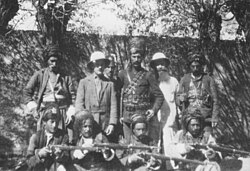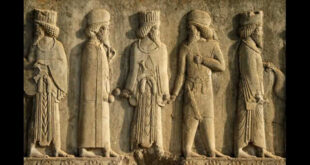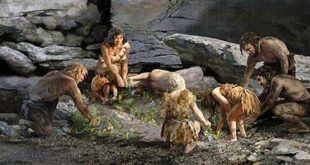| Simko Shikak Revolt | |||||||
|---|---|---|---|---|---|---|---|
| Part of 1921 Persian coup d’état and Kurdish separatism in Iran | |||||||
 Simko (center) |
|||||||
|
|||||||
| Belligerents | |||||||
Rebels
|
|||||||
| Commanders and leaders | |||||||
| Simko Shikak
Seyyed Taha Shamzini |
Amir Ershad | ||||||
| Strength | |||||||
| 1,000 (early stage) – 5,000 (later stage)[1] Several hundred Ottoman soldiers and Turkish mercenaries[2] [3] |
10,000 | ||||||
| Casualties and losses | |||||||
| 2,500 killed, captured and wounded[1] | 200 killed, captured and wounded[1] | ||||||
| Total: ~5,000 killed | |||||||
After Brigadier-General Reza Khan deposed the Qajars in an 1921 coup, he defeated Simko Shikak as well as several prominent rebel commanders such as Kuchik Khan and Colonel Pessian during the Iranian events of 1921. The Shikak rebellion resulted in some 5,000 killed, including many Assyrian civilians, who were massacred by Simko’s forces.[5]
History
Early insurrection and the massacre of Assyrians
In March 1918, under the pretext of meeting for the purpose of cooperation, Simko arranged the assassination of the Assyrian Church of the East patriarch, Mar Shimun XIX Benyamin, ambushing him and his 150 guards, as Mar Shimun was entering his carriage. The patriarchal ring was stolen at this time and the body of the patriarch was only recovered hours later, according to the eye-witness account of Daniel d-Malik Ismael.[6][7][8]
Simko and his men massacred Assyrians in Khoy. A missionary described this period as a reign of terror for Muslims hard to imagine.[9] Simko also instigated the massacre of 1,000 Christians in Salmas.[10]
Assyrian retaliation
On March 16 after the murder of Mar Shimun, Assyrians under the command of Malik Khoshaba and Petros Elia of Baz attacked Simkos’ fortress in Charah in which Simko was decisively defeated.[11] The fortress of Charah had never been conquered previously despite attempts by Iranians and the river was red from the blood of dead Shikak fighters. [12] Simko was panic stricken during the battle and managed to escape, abandoning his men.[13]
Revolt
By summer 1918, Simko had established his authority over the regions west of Lake Urmia.[14] In 1919, Simko organized an army of 20,000 Kurds and managed to secure a self-governed area in northwestern Iran, centered in the city of Urmia. Simko’s forces had been reinforced with several hundred soldiers and mercenaries from the Ottoman Empire, including Kurdish deserters and nationalists.[2] After taking over Urmia, Simko appointed Teymur Agha Shikak as the governor of the city. Later, he organized his forces to fight the Iranian army in the region and managed to expand the area under his control to the nearby towns and cities such as Mahabad, Khoy, Miandoab, Maku and Piranshahr in a series of battles.
In the battle of Gulmakhana, Kurdish forces under the command of Simko Shikak took control over Gulmakhana and the Urmia-Tabriz road from Iranian forces. In the battle of Shekar Yazi, the commander of the Iranian Army, General Amir Ershad, was killed. In the battle of Miandoab, Reza Shah, dispatched Khaloo Qurban to counter Kurdish expansion, but he was defeated and killed by Simko’s forces in 1922. In the battle for the conquest of Mahabad (then named Savoujbolagh Mokri), Simko himself commanded his forces with the help of Seyyed Taha Shamzini. After a tough battle in October 1921, Iranian forces were defeated and their commander Major Malakzadeh along with 600 Iranian Gendarmeries was killed. Simko also conquered Maragheh and encouraged the Lurs tribes of western Iran to revolt.
At this time, the government in Tehran tried to reach an agreement with Simko on the basis of limited Kurdish autonomy.[15] Simko had further organized a Kurdish army, which grew stronger and stronger. Since the central government could not control his activities, he continued to expand the areas of western Iran under his control. By 1922, the cities of Baneh and Sardasht were under his administration.[16]
In the battle of sari Taj in 1922, Simko’s forces could not resist the Iranian Army’s onslaught in the region of Salmas and were finally defeated and the castle of Chari, where Simko’s forces were camping, was occupied. The strength of the Iranian Army force dispatched against Simko was 10,000 soldiers.[17] Simko and one thousand of his mounted soldiers, took refuge in what was now Turkey, where they were forced to lay down their weapons.
Aftermath
By 1926, Simko had regained control of his tribe and begun the another rebellion.[1] When the army engaged him, half of his troops betrayed him to the tribe’s previous leader and Simko fled to Iraq.[1]
In 1930, the commander of the Iranian Army, General Hassan Muqaddam sent a letter to Simko, who was residing in the village of Barzan, and invited him for a meeting in the town of Oshnaviyeh. After consulting with his friends, Simko along with Khorshid Agha Harki went to Oshnaviyeh and were invited to the house of the local army commander, Colonel Norouzi, and were told to wait for the Iranian general. Colonel Norouzi convinced Simko to go to the outskirts of the town to welcome the general’s arrival. However, this was a trap, and Simko was ambushed and killed on the evening of June 30, 1930.
References
- ^ a b c d e f g Smith, B. (2009). “Land and Rebellion: Kurdish Separatism in Comparative Perspective” (PDF). Working Paper.
- ^ a b c Bruinessen, Martin (2006). “Chapter 5: A Kurdish warlord on the Turkish-Persian frontier in the early Twentieth century: Isma’il Aqa Simko”. In Atabaki, Touraj (ed.). Iran and the First World War: Battleground of the Great Powers. Library of modern Middle East studies, 43. London; New York: I.B. Tauris. pp. 18–21. ISBN 9781860649646. OCLC 56455579.
- ^ Arfa, Hassan (1966). The Kurds: An Historical and Political Study. London: Oxford University Press. p. 57. OCLC 463216238.
- ^ Allen, William Edward David; Muratoff, Paul (1953). Caucasian battlefields: A History of the Wars on the Turco-Caucasian border, 1828-1921. Cambridge: Cambridge University Press. p. 296. OCLC 1102813.
- ^ Maria T. O’Shea, “Trapped Between the Map and Reality: Geography and Perceptions of Kurdistan”, Routledge, 2004. p. 100: “Simultaneously, a 1000 Christians were killed in Salmas, in a massacre instigated by Simko.”
- ^ Houtsma, M. Th.; van Donzel, E. (1993). E. J. Brill’s First Encyclopaedia of Islam, 1913–1936. p. 118. ISBN 90-04-08265-4.
- ^ O’Shea, Maria T. (2004). Trapped Between the Map and Reality: Geography and Perceptions of Kurdistan. New York: Routledge. p. 100. ISBN 0415947669.
Simko later arranged the assassination of Mar Shamon, the Assyrian patriarch in March 1918, under the pretext of a meeting to discuss cooperation.
- ^ Nisan, Mordechai (2002). Minorities in the Middle East: A History of Struggle and Self-Expression (2nd ed.). Jefferson, NC: McFarland. p. 187. ISBN 0786413751.
Simko, their leader in Iran, had invited Mar Shimon for conference in Kuhnehshahr, west of Salmas, kissed him—and then treacherously murdered the Nestorian patriarch and his men
- ^ Joseph, John (2000). The Modern Assyrians of the Middle East: Encounters With Western Christian Missions, Archaeologists, and Colonial Power. Studies in Christian Mission (Hardcover ed.). Boston: Brill. p. 147. ISBN 9004116419.
- ^ O’Shea, Maria T. (2004). Trapped Between the Map and Reality: Geography and Perceptions of Kurdistan. New York: Routledge. p. 100. ISBN 0415947669.
Simultaneously, 1,000 Assyrians were killed in Salmas, in a massacre instigated by Simko.
- ^ Ismael, Yaqou D’Malik (2020-11-13). Assyrians and Two World Wars: Assyrians from 1914 to 1945. Ramon Michael. p. 152.
- ^ Ismael, Yaqou D’Malik (2020-11-13). Assyrians and Two World Wars: Assyrians from 1914 to 1945. Ramon Michael. p. 152.
- ^ Ismael, Yaqou D’Malik (2020-11-13). Assyrians and Two World Wars: Assyrians from 1914 to 1945. Ramon Michael. pp. 151–152.
- ^ Elphinston, W. G. (1946). “The Kurdish Question”. International Affairs. 22 (1): 91–103 [p. 97]. doi:10.2307/3017874. JSTOR 3017874.
- ^ McDowall, David (1991). “The Kurds in Iran”. The Kurds. London: Minority Rights Group. ISBN 0946690928. Archived from the original on September 29, 2007.
- ^ Koohi-Kamali, F. (1992). “Nationalism in Iranian Kurdistan”. In Kreyenbroek, P. G.; Sperl, S. (eds.). The Kurds: A Contemporary Overview. Routledge. pp. 175–176. ISBN 0-415-07265-4.
- ^ Cronin, S. (2000). “Riza Shah and the disintegration of Bakhtiyari power in Iran, 1921–1934”. Iranian Studies. 33 (3–4): 349–376 [p. 353]. doi:10.1080/00210860008701986. S2CID 154157577.
- ^ Cronin, Stephanie (2002). “British Influence During the Rezā Shāh Period, 1921–41”. Encyclopedia Iranica. Retrieved 2012-08-03.
- ^ “Kurdish Republic Formed; Simko, Bandit Leader, Said to Have Defeated Iranian Troops” (PDF). New York Times. July 10, 1922.
- ^ Sanasarian, Eliz (2000). Religious Minorities in Iran. New York: Cambridge University Press. p. 178. ISBN 0521029740.
Simko’s forced joined with the Turks and killed many escaping Christians.
- ^ a b c d e f See:
* Entessar, Nader (2010). Kurdish Politics in the Middle East. Lanham: Lexington Books. p. 17. ISBN 9780739140390. OCLC 430736528.* Kreyenbroek, Philip G.; Sperl, Stefan (1992). The Kurds: A Contemporary Overview. London; New York: Routledge. pp. 138–139. ISBN 9780415072656. OCLC 24247652. - ^ Asatrian, Garnik (2009). “Prolegomena to the Study of the Kurds”. Iran and the Caucasus. 13 (1): 65–66. doi:10.1163/160984909X12476379007846.
- ^ Ahmadi, Hamid (2013). “Political Elites and the Question of Ethnicity and Democracy in Iran: A Critical View”. Iran and the Caucasus. 17 (1): 84–85. doi:10.1163/1573384X-
 History of Kurdistan
History of Kurdistan



